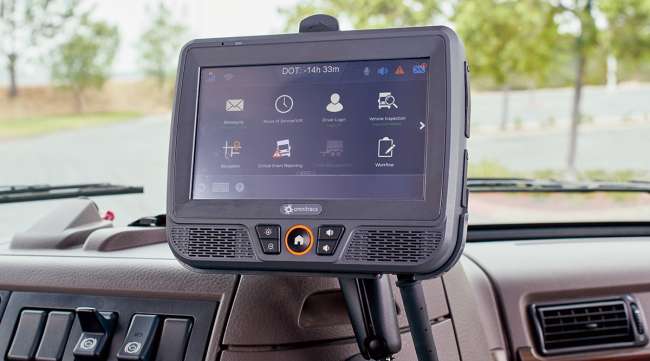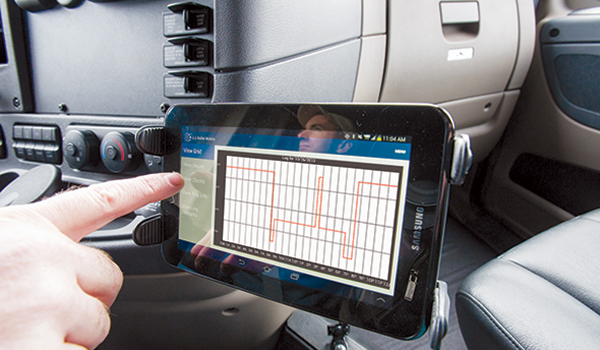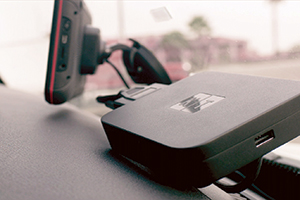Android’s Rise in Trucking

The mobile device revolution has dramatically altered telematics and mobile communications in the trucking industry as technology suppliers have introduced an ever-expanding array of business applications for smartphones and tablets.
But the change didn’t stop there.
Even traditional in-cab terminals with fixed-mount displays — which remain popular with many fleets — have been migrating to Android, the operating system behind much of the consumer mobile device market.
This shift ultimately will give carriers using hard-wired systems access to the same types of Android-based applications that are available on handheld smart devices, technology vendors said.
Although more consumer mobile devices run on Android than any other mobile operating system on a worldwide basis, Apple’s iOS holds the lead in the U.S. market with about a 55% share, compared with 45% for Android, according to web traffic analysis tool StatCounter.
But Android, which is developed by Google, has garnered a higher level of support from trucking’s technology suppliers. Telematics vendors said Android is more open to app developers, whereas Apple requires developers to complete certain steps to have their apps certified to run on iOS.
“Like many in the industry, we’ve standardized on Android,” said Adrian Harding, director of product strategy at Trimble Transportation, which includes the trucking telematics business previously known as PeopleNet.
Android-based devices are being purchased “by carriers large and small” for drivers, and truck manufacturers are installing Android in their tractors, Harding said. “As a result, when we think of the software we would build, we see a clear need for Android-couched apps.”
Omnitracs, another major supplier of mobile communications systems for trucking, also has been moving toward Android. The company plans to convert its flagship in-cab system, the Intelligent Vehicle Gateway, or IVG, to the Android operating system as it converges its fixed-mount and mobile device-based product lines under its Omnitracs One platform.
The rise of Android in trucking telematics is part of a larger trend toward mobile technology in the business world.
Technology is used not just in vehicles, but for obtaining signatures and performing other tasks outside the truck cab, said Kevin Aries, global product success leader for Verizon Connect.
“Fixed-mount or in-dash devices don’t offer that mobility,” he said. “Drivers and workers need technology in the palm of their hands.”
Verizon Connect, which acquired telematics companies Telogis and Fleetmatics in recent years, has placed a heavy focus on Android-based mobile devices.
The multitude of different Android devices in the market, versus a couple of dozen iOS devices, was a “driving factor” in Verizon Connect’s commitment to developing applications for Android users, Aries said.
“Solution providers aren’t driving this, business consumers are — and the providers are following,” he added.
At the same time, the wide range of price points for Android devices enables small and midsize businesses to invest in technology without breaking the bank, Aries said.
Android has become “the predominant player in the mobile device area across all verticals,” said Ralph Lieberthal, principal for transportation and logistics at Zebra Technologies, a major supplier of handheld devices for trucking, parcel delivery and warehouse workers.
“There aren’t any alternatives,” Lieberthal said. “Microsoft has basically moved out.”
Prior to Android’s ascent, the typical handheld devices used by frontline workers had run on the Windows CE operating system, but Microsoft discontinued that platform years ago, so apps and content are now limited, said Rob Smith, an analyst for Gartner.
“Android is becoming the new go-to OS for frontline workers,” he said.
Smith added that iOS — the operating system for Apple’s iPhone and iPad — requires “a much higher initial investment cost versus Android.”
The size and shape of computer hardware — its “form factor” — play a major role in the telematics choices that carriers make, Trimble’s Harding said.
He pointed to the variety of hardware options available to carriers on the Android platform, particularly in contrast to Apple.
“There are only so many variations of the iPad and the iPhone, and there are a lot more variations of Android-equipped devices,” Harding said.
The advent of touch screens enabled a change in the form factor of mobile devices. Once keys and buttons were no longer needed, the display screen could be enlarged, allowing for “more rich visual applications,” said Larry Jordan, chief product officer for trucking telematics vendor Zonar Systems.
Jordan described Android as “a very easy ecosystem” for developers.
Carriers looking for telematics services from a fleet-management technology provider also are in search of specialized applications, Jordan said. “Android allows these customers to put different solutions from Zonar and from third-party providers onto the same tablet.”

Many suppliers of electronic logging devices use Android and Apple smartphones and tablets as the driver's display. (J.J. Keller & Associates)
Nonetheless, some trucking telematics providers said they also strive to make their offerings compatible with Apple’s iOS devices, particularly as some carriers utilize a “bring your own device” strategy.
“There will continue to be a mix of some use for Android and some use for iOS,” Jordan said.
Many suppliers of telematics systems and electronic logging devices have embraced the BYOD approach, in which drivers can access work applications with their own devices.
J.J. Keller & Associates’ target market for its ELD is “anyone that could be bringing a device,” said Paul Schwartz, vice president of technology solutions.
The company’s telematics product is independent of any single mobile operating system because it uses a piece of hardware that plugs into the vehicle and connects wirelessly with the driver’s mobile device.
“We don’t have a user interface on our electronic logging device,” Schwartz said. “It’s the mobile device or tablet that provides that interface.”
All of J.J. Keller’s initial market releases are on the Android platform first.
“It’s the nature of the process with Apple to have equipment certified,” Schwartz said. “The relative closed nature of the Apple ecosphere [includes] having hardware validated and authorized. There’s a bunch of challenges beyond technical development that Apple puts in your way that Android really doesn’t. You can write for an Android device and … there isn’t any barrier to entry.”

KeepTruckin's ELD system uses a small piece of hardware in the cab that connects with drivers' mobile devices. (KeepTruckin)
KeepTruckin also offers a mobile-device-based ELD and telematics system.
Seth Spiel, KeepTruckin’s head of telematics, described the ongoing changes in the trucking telematics business as “a transition from fixed-mount systems to bring your own devices, or more mobile devices.”
Mobile devices are easier to use, easier to adopt at a lower cost, and they allow trucking, as well as other industries, to take advantage of a shift from application-specific terminals to general devices with application-specific software, he said.
And with more people using smartphones, “Fleets are also taking that route because it’s cheaper and easier to get their drivers up and running,” added Jason Pesek, product manager for compliance and mobile at KeepTruckin.
Spiel also remarked on a recent shift toward Android among KeepTruckin’s customers.
“In 2018, our customer base was almost exactly 50-50 — Android and iOS,” Spiel said. “Today, in 2019, it’s 59% Android and 41% iOS.”
He cited a number of factors for that change.
“Android tends to be more diverse and flexible; it supports whatever experience you want, and they also offer a better cost-value proposition,” Spiel said. “iOS has staked out the more premium section of the market and is more privacy focused.”
The market “appreciates diversity and value, and so that gives Android a general edge,” Spiel said. ³




